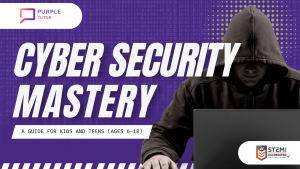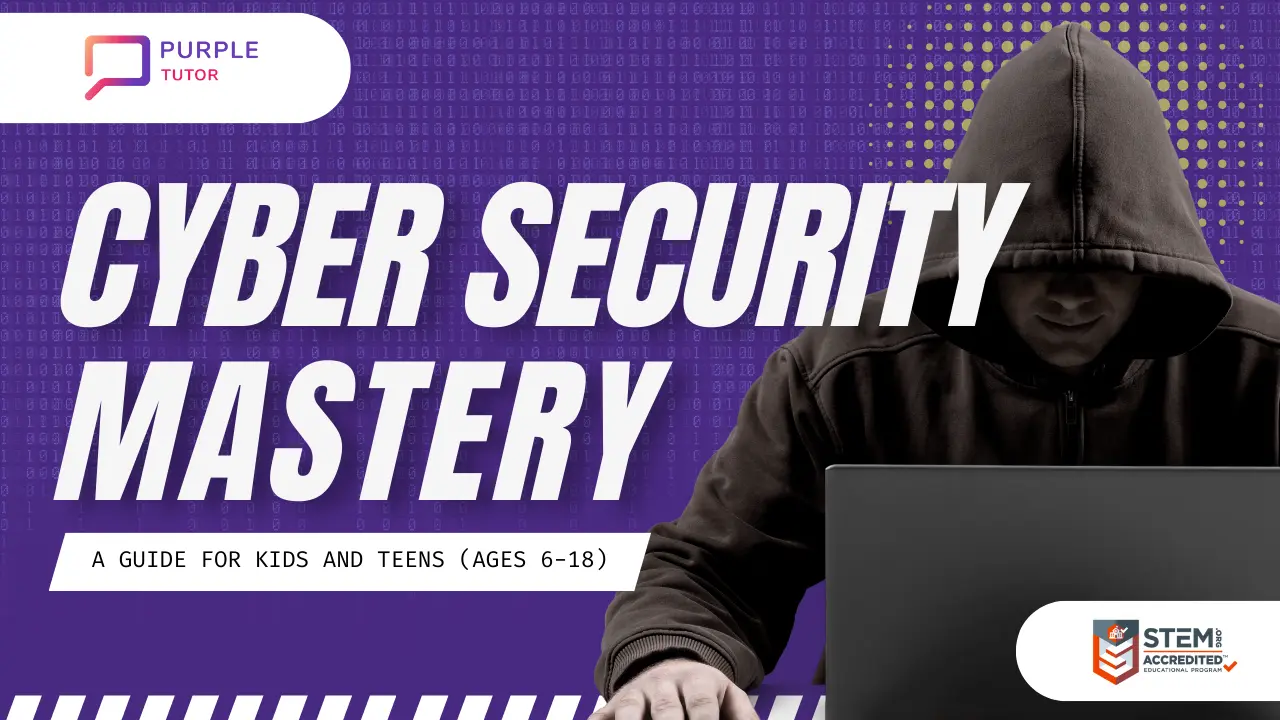 Cyber security is essential for kids and teens in the digital age. With technology playing a pivotal role in their lives, it’s more important than ever for them to understand and master cyber security principles. This comprehensive guide is designed specifically for kids and teenagers, aged 6-18, providing them with the knowledge and skills needed to navigate the digital world safely.
Cyber security is essential for kids and teens in the digital age. With technology playing a pivotal role in their lives, it’s more important than ever for them to understand and master cyber security principles. This comprehensive guide is designed specifically for kids and teenagers, aged 6-18, providing them with the knowledge and skills needed to navigate the digital world safely.
In an era where online interactions, gaming, and education are increasingly prominent, it’s crucial for the younger generation to grasp the concepts of cyber security, computer security, IT security, digital security, and be aware of cyber security threats. This guide serves as a beacon, illuminating the path to digital safety and expertise for kids and teens.
Understanding Cyber Security
In the realm of computer security, we find ourselves in a fortified bastion, a digital guardian of utmost importance. This formidable stronghold stands as a formidable protector, a barrier against the relentless onslaught of potential digital threats. Its primary mission: to ensure the sanctity and integrity of your digital domain.
Imagine it, if you will, as a mystical incantation, a powerful spell woven to safeguard your virtual sanctuary from the menacing “dragons” that lurk in the online abyss. Just as knights would defend their castles against marauding dragons in the days of yore, so does computer security stand as the valiant protector of your digital fortress.
In the exciting tapestry of online adventures and academic quests, computer security serves as your unwavering shield. It fortifies your digital realm, ensuring that your online pursuits, whether it be gaming or completing homework, remain a sanctuary of uninterrupted exploration and learning. So, young digital adventurers, take heed and embrace the wisdom of computer security, for it is the enchanted armor that safeguards your journey in the ever-evolving digital landscape.
IT Security Simplified for Young Learners
IT security, or Information Technology security, is like a protective shield for all things related to computers and the Internet. Picture your computer as a valuable treasure chest, and IT security is the lock and key that keeps it safe from prying eyes. It’s like having a guardian dragon that only lets in those who have the secret code or the right key, ensuring that your digital treasures remain secure.
Digital Security: Building an Online Fortress
Digital security is akin to constructing a well-defended castle to safeguard your online activities from cyber villains. Envision it as a formidable fortress with unbreakable walls made of strong passwords and vigilant gatekeepers in the form of security software. This imagery aids children and teens in understanding the critical role of digital security in protecting their online world. Just as a castle ensures the safety of its inhabitants, digital security ensures the integrity of your personal information, digital assets, and online journeys, empowering young minds to grasp its significance.
Cyber Security Threats Explained
Let’s delve into cyber security threats in a way that’s understandable for kids and teens. Just like in superhero stories where heroes need to identify their adversaries’ weaknesses, it’s important to know about these “bad actors” in the digital world to protect yourself online.
- Hackers: Imagine hackers as digital spies who try to break into your online accounts or devices. They want to steal your information, like passwords or personal details. To protect yourself, use strong and unique passwords for your accounts, change them regularly, and don’t share them with anyone.
- Phishing: Phishing is like a cunning trap. Cybercriminals send fake emails or messages pretending to be from trusted sources, like your favorite game or a social media site. They ask for your login details or personal information. Always be cautious and double-check the sender’s email or website address before sharing any information.
- Malware: Malware is like a sneaky virus that can infect your devices. It can slow them down or steal your information. Be careful about downloading files or apps from unknown sources. Make sure you have good antivirus software to protect your devices.
- Cyberbullying: Cyberbullying is like a villain who uses the internet to hurt others. It includes mean messages, spreading rumors, or even sharing embarrassing photos. If you ever experience cyberbullying, talk to a trusted adult about it and block the person responsible.
- Online Scams: Scams are like digital tricksters who promise something exciting, like free games or prizes. They might ask for money or personal information in return. Always check with a trusted adult before engaging with anything that seems too good to be true.
- Privacy Invasion: Sometimes, people might try to snoop into your online life, much like nosy neighbors. They might try to access your social media accounts or track your online activities. It’s essential to adjust your privacy settings on social media and be careful about what you share.
- Gaming Threats: In the gaming world, there are cheaters who use hacks to win unfairly. These cheaters can ruin the fun of games. Always play fair and report any cheaters to the game administrators.
Remember, just like superheroes need their gadgets and strategies to fight the villains, you can protect yourself in the digital world by being cautious, using strong passwords, and seeking help from trusted adults when something doesn’t seem right. Cybersecurity is like your shield, keeping you safe online.
Identifying Vulnerabilities in Cyber Security: A Primer for Young Minds
Vulnerabilities in cyber security are like chinks in your armor. Even superheroes have vulnerabilities. These vulnerabilities are the weak points that hackers exploit. By learning about them, kids and teens can bolster their online defenses.
Key Tips to Teach Kids about Cybersecurity and Online Safety
Before diving into PurpleTutor’s offerings, it’s essential to impart some key tips for teaching kids about cybersecurity and online safety. These tips will serve as foundational knowledge:
- Use age-appropriate language and examples to explain cyber threats and security measures.
- Encourage open communication about online experiences and concerns.
- Teach the importance of strong, unique passwords and regular updates.
- Emphasize the significance of not sharing personal information online.
- Promote responsible online behavior, including kindness and respect towards others.
PurpleTutor Cyber Security Course: Tailored for Young Minds
In today’s digital landscape, the importance of cybersecurity cannot be overstated. As technology advances, so do the threats posed by cybercriminals. At PurpleTutor, we recognize the need for empowering young minds with the knowledge and skills to protect themselves in the digital world.
Our Cyber Security Course is meticulously crafted to address the unique needs of kids and teens. Here’s what sets PurpleTutor apart:
- Tailored Learning: We understand that young minds have specific requirements. Our course is custom-tailored to make cyber security concepts accessible and engaging for them.
- Expert Instructors: Our instructors are experts in the field, ensuring that students receive the highest quality education. They guide young learners through the intricacies of cyber threats and countermeasures.
- Hands-On Learning: We believe in learning by doing. Our course includes practical, hands-on exercises to reinforce cybersecurity principles.
- Real-World Relevance: We don’t just teach theory; we equip students with skills that are immediately applicable in the real world. They learn to identify and combat cyber threats effectively.
- Safe Learning Environment: PurpleTutor provides a secure online platform where kids and teens can learn without fear, fostering a positive and supportive learning environment.
Advantages of PurpleTutor Live Classes
- Engaging Content for Young Learners: PurpleTutor’s lessons are thoughtfully crafted to captivate young minds, incorporating games, stories, and activities to make cyber security fun.
- Expert Instructors: Our courses are led by cyber security experts who excel in simplifying complex concepts, ensuring easy comprehension.
- Parent Involvement: PurpleTutor recognizes that cyber security is a family matter. Parents can join our classes to enhance their knowledge and actively participate in their child’s learning journey.
- Hands-On Learning: Our live classes include practical exercises, allowing students to apply what they’ve learned in a safe, controlled environment.
Conclusion
Cyber security is an essential skill for today’s youth, and PurpleTutor’s live classes provide an ideal platform to master it. Empower your children with the knowledge and skills needed to navigate the digital world safely. Join PurpleTutor and embark on a journey to cyber security mastery that’s engaging, interactive, and tailored to young minds. Protect, learn, and grow with PurpleTutor’s live classes.
Empower your children with essential cyber security skills through PurpleTutor’s engaging, interactive live classes. Join us now and embark on a journey to cyber security mastery, tailored to young minds. Safeguard their digital future.
Frequently Asked Questions (FAQs)
1. Can I experience a free demo class?
A: Absolutely, the first demo class is offered at no cost. You can secure your free class by clicking the booking link.
2. Is the coding course schedule adaptable?
A: Our kids’ coding courses offer flexibility. You can choose a time and day that aligns with your child’s availability.
3. How can I determine the right coding course for my child?
A: Our teachers evaluate your child’s level during the demo class, and based on that assessment, we recommend a suitable course.
4. Will my child receive a certification?
A: Yes, upon successfully completing each course, students receive a certificate that acknowledges their acquired skills and level of mastery.
5. What is needed to learn coding with Purple Tutor?
A: To get started, you’ll need a laptop or computer equipped with a webcam and a reliable internet connection.
